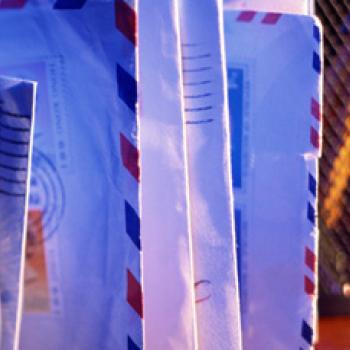A Genre Study of Letters With The Jolly Postman

- Preview |
- Standards |
- Resources & Preparation |
- Instructional Plan |
- Related Resources |
- Comments
Overview
In this lesson, The Jolly Postman is used as an authentic example to discuss letter writing as a genre. Students explore the letters to the storybook characters delivered by The Jolly Postman. They then learn how to categorize their own examples of mail. The Jolly Postman uses well-known storybook characters, from fairy tales and nursery rhymes, as recipients of letters. This children's storybook is therefore ideal for using as a review of these genres of literature and as a means of helping children begin to explore rhyme and a variety of writing styles. Several pieces of literature appropriate for use with this lesson are suggested.
Featured Resources
Picture Books That Feature Letters: This printable booklist contains a list of children's books that feature letters in the story.
Letter Attributes Chart: This printable chart describes the characteristics of friendly, business, and persuasive letters.
Letter Generator: This online tool allows students to read about the parts of a letter. They can then write and print their own friendly or business letter.
From Theory to Practice
In "Reading to Students as Part of Genre Study," Dick Koblitz explains, "One of the reasons I read aloud daily to the six- to nine-year-old students in my multiage primary classroom is to introduce a genre. This has deepened the more intensive genre study that my students and I do in our literature group discussions" (1). In Koblitz's classroom, "Constructing meaning from a text or about a particular genre of literature occurs before, during, and after the read-aloud session" (1). Before beginning to read, Koblitz shares basic information about the genre. During the reading, Koblitz pauses to explore vocabulary and identify conventions. After reading, students make predictions about what will happen next. Koblitz concludes that "using interactive read-alouds can be powerful in helping students to discover the literary elements of a particular genre of literature. They always want to read more books by the same authors or in the same genre. And they will often begin to write their own stories in the genre, incorporating many of the same rules and structures of the more experienced authors" (2). This lesson plan follows a similar process, using The Jolly Postman as a read-aloud text that leads to genre exploration and serves as a model for students' own writing.
Further Reading
Common Core Standards
This resource has been aligned to the Common Core State Standards for states in which they have been adopted. If a state does not appear in the drop-down, CCSS alignments are forthcoming.
State Standards
This lesson has been aligned to standards in the following states. If a state does not appear in the drop-down, standard alignments are not currently available for that state.
NCTE/IRA National Standards for the English Language Arts
- 1. Students read a wide range of print and nonprint texts to build an understanding of texts, of themselves, and of the cultures of the United States and the world; to acquire new information; to respond to the needs and demands of society and the workplace; and for personal fulfillment. Among these texts are fiction and nonfiction, classic and contemporary works.
- 2. Students read a wide range of literature from many periods in many genres to build an understanding of the many dimensions (e.g., philosophical, ethical, aesthetic) of human experience.
- 3. Students apply a wide range of strategies to comprehend, interpret, evaluate, and appreciate texts. They draw on their prior experience, their interactions with other readers and writers, their knowledge of word meaning and of other texts, their word identification strategies, and their understanding of textual features (e.g., sound-letter correspondence, sentence structure, context, graphics).
- 4. Students adjust their use of spoken, written, and visual language (e.g., conventions, style, vocabulary) to communicate effectively with a variety of audiences and for different purposes.
- 5. Students employ a wide range of strategies as they write and use different writing process elements appropriately to communicate with different audiences for a variety of purposes.
- 6. Students apply knowledge of language structure, language conventions (e.g., spelling and punctuation), media techniques, figurative language, and genre to create, critique, and discuss print and nonprint texts.
- 9. Students develop an understanding of and respect for diversity in language use, patterns, and dialects across cultures, ethnic groups, geographic regions, and social roles.
- 11. Students participate as knowledgeable, reflective, creative, and critical members of a variety of literacy communities.
- 12. Students use spoken, written, and visual language to accomplish their own purposes (e.g., for learning, enjoyment, persuasion, and the exchange of information).
Materials and Technology
- The Jolly Postman and Other People's Letters by Janet Ahlberg and Allen Ahlberg (Little Brown, 1986)
- Paper and pencil
- Examples of letters
- Picture Books That Feature Letters
Printouts
Preparation
- Prepare chart paper for a class Letter Attributes Chart.
- Make copies of the Type of Letter Worksheet or prepare an overhead or chart paper to record students' observations.
- Gather sample letters to share with students during the lesson.
- Test the Letter Generator on your computers to familiarize yourself with the tools and ensure that you have the Flash plug-in installed. You can download the plug-in from the technical support page.
Student Objectives
Students will
- read and discuss The Jolly Postman.
- explore characters from well-known stories.
- examine parts of a letter.
- research the different genres of mail.
- categorize letters from The Jolly Postman by looking at their attributes.
- demonstrate an understanding of parts of letters and letter genres by writing original letters.
Session One
- Introduce the genre by discussing letters and letter writing, using the following questions as a guide:
- Do you like to get mail?
- What are some reasons that people write letters?
- What type of letter would you write if someone gave you a gift?
- What type would you write if you broke a friend's toy?
- What type would you write if you were having a party?
- Do you like to get mail?
- Talk with the students about the different types of letters that a letter carrier has to deliver. For example, there are formal letters, chatty notes, and invitations.
- Post a piece of chart paper and list these types of letters.
- Ask the children about other kinds of letters might be sent through the mail. As students brainstorm, add the kinds of letters to the chart paper.
- Critically read The Jolly Postman. Begin by summarizing the story: the book tells about the mail that a letter carrier delivers to fairy tale characters.
- Show the design of the book, focusing on the fact that some pages tell parts of the story in rhyme while some pages are actually the letters that the Postman in the book delivers. Discuss the format of the book and the different characters introduced.
- Read the book, being sure to read and display each letter and envelope. As you read each letter, you might pass the piece to students to look at more closely as you continue reading.
- Once you've finished the book, ask students to help you put the letters back in the right envelopes. As you go through the book another time, encourage students to use clues on the letters and envelopes to match the letters with their envelopes in the book.
Session Two
- Show an example of a letter and an envelope that has already been prepared. You can use an example from the book or a letter that you have on hand.
- As a class, look at different types of mail-friendly letters, business letters, persuasive letters, greeting cards, and so forth. Discuss the similarities and differences of each type. Encourage students to use their own letters to find examples of the various parts of letters as they are discussed.
- Together, create a chart listing the characteristics of each type of mail. See the attachment as an example.
- Use the Type of Letter Worksheet, categorize the letters delivered by The Jolly Postman, based upon the class's letter description chart.
- As homework, have the students bring in examples of mail they receive at their home.
Session Three
- Review the chart of characteristics created in the previous session. Answer any questions students have.
- Divide students into small groups, and ensure that each group has at least four to five letters.
- Based upon the class's letter description chart, have students categorize the examples of mail they brought from home.
- Circulate among students as they work, answering any questions and watching for evidence that students are using genre characteristics to sort the letters.
- Once students have sorted all their letters, bring the class together again and ask them to share what they found as they worked with their letters. Ask students to share the reasons that they categorized the letters as they did.
- Ask students to share any letters that didn't match the characteristics on the chart. Adjust the chart as necessary—either adding a category of letters or refining the characteristics.
Extensions
- Share The Jolly Christmas Postman by Janet and Allan Ahlberg (Little Brown & Co, 2001) or another picture book that focuses on letters with your class. As a chapter-book read-aloud, share Beverly Cleary's Dear Mr. Henshaw.
- As an alternative to letter writing, use the interactive Postcard Creator to create original postcards. After printing their text, students can illustrate the front of the cards using markers or other art supplies.
- Use the ReadWriteThink lesson plan Who's Got Mail? Using Literature to Promote Authentic Letter Writing to structure additional letter writing activities in your classroom.
Student Assessment / Reflections
Demonstrate the Letter Generator for students. Ask students to choose characters from The Jolly Postman and share one of the scenarios below:
- One of the characters from the book has decided that it would be nice to create a community garden. Write letters that the characters might share about the plans.
- One of the characters from the book wants to start a community recycling center. Write letters that the characters might send or receive in this scenario.
- One of the characters from the book would like to start a town newspaper. Write letters that the characters might send or receive in this scenario.
As a group brainstorm the things that the characters might write to one another in response to the particular scenario, listing the options on a sheet of chart paper. Once you've created a list that provides several possibilities for students to choose among, ask students to write their own letters using the Letter Generator based on the scenario. At a minimum, ask students to write at least two different kinds of letters. Assess the letters by comparing the work that students have created to the characteristics chart. If letters depart from the chart, discuss the comparison with the individual student and provide direct instruction to help the student understand the differences between the types of letters.

Add new comment